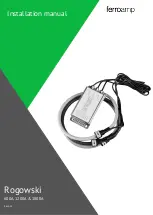
RXT-300 SmartWireless™
RXT-300 Wireless IM
Rev. 2.0
Page 12 of 41
2.3
Wiring Connections / Functions
Depending on use and function, the RXT-300 wireless transceiver can be wired in different ways to different
devices. It is important to insure that the wiring is correct for the device to operate properly. Wire
identification for the transceiver can be found in Table 2
RXT-300 Transceiver Wire Identification
.
Table 2
RXT-300 Transceiver Wire Identification
Function
Color Reference
VDC Power (+)
Red
VDC Return (-)
Black
Modbus™ A (+)
Blue
Modbus™ B (-)
White
Alarm 0
Brown
Alarm 1
Orange
Alarm 2
Violet
Alarm 3
Gray
4-20mA A
Green
4-20mA B
Yellow
Serial Clock (SCL)
White/Black
Serial Data Line Data (SDA)
White/Brown
Programming Data
White/Green
Programming Clock
White/Blue
Programming Reset
White/Violet
NOTE:
Reference Figure 18 through Figure 25 at the end of this manual for multiple wiring
examples.
2.3.1
VDC Power & VDC Return
All RXT-300 wireless transceivers need to have DC power applied to the transceiver’s red (VDC power) and
black (VDC return) wires. The power requirements for the transceiver are such that the DC voltage input
range is 7 to 30 volts. This power will normally be supplied by the device the transceiver is connected to, but
can come from alternate DC sources such as the optional Smart Battery Pack, solar panel or external customer
supplied DC source.
If an external power source is installed, the RXT-300 wireless transceiver requires two conductor connections
for the power supply. External DC power can be customer provided with an output voltage range between 7 to
30VDC or by Detcon’s optional 24VDC solar charging panel. Both of these alternatives will provide
continuous operation of the assembly and can be installed in conjunction with the optional battery pack,
providing a constant power source. The external power supply will also maintain the battery pack fully
charged with no overcharging issues to be concerned with due to the battery pack’s “smart” circuitry. In this
configuration, external charging of the battery pack will not be necessary. In the event the external power
fails, the battery pack will continue to power the wireless transceiver assembly until external power is restored
or the battery is discharged.
If the Model 100 Terminal Board option is not used, power to the transceiver should be directly applied to its
red and black wires accordingly. If the terminal board is used, wiring designations for power are ‘+’ and ‘-’
(External DC Power In) on the J5 connector of the Model 100 Terminal Board. The maximum wire length
between the transceiver assembly and a 24VDC source is shown in Table 3
















































